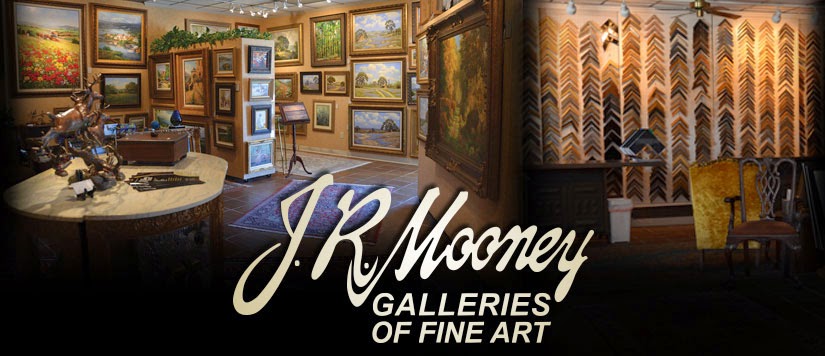Check out our newest edition of "Mooney Makes Sense" column in the May 2015 edition of Boerne Business Monthly Magazine
Read it here at:http://issuu.com/boernemag/docs/may_2015_bbm_online
The Online World and the Art World
“Why It Matters That They Interact”
By; Gabriel
Diego Delgado,
Gallery Director, J.R. Mooney Galleries-
Boerne
The internet is such a big part of our
lives. We shop, talk, interact, search,
post, tweet, synch, launch, browse, pin, sell, work and do an array of other activities
on our computers, smartphones, tablets, i-wear and other internet devices.
So, I want
to take a moment and give an internet refresher to all the art buyers,
collectors, gallerists and artists reading this column.
Over the
last two decades, the art world has morphed, contorted and distorted, but above
all ADAPTED to the World Wide Web. Sure, artists can build their own websites
to sell and feature their own art. But, who sees it? Who knows what is out
there in all the undiscovered websites, dark net, and torrents. The question is
how does one find art or artists online within the 800 million plus websites
and millions more apps? Google is constantly changing its algorithms discombobulating
the searchable website databases, forcing artists to be smart, tech savvy
business people as they try to figure out how to show up in the skewed results.
Let’s review
the role of social media platforms in the arts. We have Facebook™, Instagram™,
Pinterest™, LinkedIn™, Vine™, Google+™, Twitter™ and many other apps and social
sharing sites that help an artist promote and sell artwork. Sure you can post,
like, share, pin, tweet, hashtag, repost, retweet, upload, feature, comment,
download and even cloud host, but does this equate sales? Not usually. O.K.
O.K. some people sell off these sites, but social media is more of just a
marketing tool used to expand an audience for the artwork. Being relevant is
the key, staying top of mind, like traditional marketing had been in the heyday
of printed paper advertisements.
Facebook™ sells ads; other websites host pop-ups and targeted audience
messaging. But again, is this equating sales in the art world? Not really. There is no one real answer for sales, but a multi-tiered
approach of repeating the visual aesthetics of the artwork on all kinds of
apps, sites, and groups. This consistent and continuous repetition of branding
and image awareness will inevitably drive traffic and sales. The artist virtual
toolbox needs to have many Swiss Army knife inspired logistical applications
for artwork promotion.
There are
tens of thousands of websites that sell/buy art. Even the retail juggernaut, Amazon.com launched
the Amazon Art portal in August 2013, partnering with over 150 galleries and
dealers to sell fine art. And of course
there is Ebay™, Craigslist™, Artsy, Etsy, DeviantArt, Storenvy, Artfire and
hundreds of other online galleries that can be searched to find the right piece
for your home or office. The more searchable the art is the better.
It is also
good to know galleries and museums around the world employ individuals whose
sole role is to market artwork, exhibitions, acquisitions and programs online.
They range from social media coordinators, communication directors, social
media managers and the like. Galleries
know the online presence is necessary to be relevant in today’s society. These
people’s job is to make sure we are paying attention to the artwork being
spotlighted by these various organizations.
One museum, Art
in Island, in Manila, Philippines even has a 3-D exhibition that encourages
museum patrons to take selfies and interact with the art, this way the people
going to the museum are doing the marketing themselves to their friends, family
and followers. On the other hand, it is
also commonplace for galleries and museums to prohibit photography, even on
smartphones and some museums have outright banned the new novelty “selfie
stick”. So if you foursquare, check-in
or Gowalla it is always appreciated by the institutions and those individuals
marketing it.
In the
nostalgic heyday of the internet, chatrooms were the buzz, AOL ruled the roost.
However, we saw the decline and flop of sites like Myspace, Friendster, and
many other not-so-household names. Google Hangouts, LinkedIn groups, circles,
and other networking sites rise and fall as many websites do. Keep in mind, although they
might eventually collapse, it is good to follow the trends, these sites is
where people are; you have to find your audience so they can find you. Don’t
worry if Facebook won’t be around in 20 years, it’s here now and people are
using it. Although teens have left it in
hordes, the fastest growing demographic for it is 45- 65 year olds; those that
having buying power. Yes, you can be fashionably late to what’s happening in
the app world, but don’t disregard it. The trends change as history has shown
us. So if you think Instagram is high
school kids sending pictures think again and post that image of your painting
and see what happens.
Get
Creative! And be prolific. There are close to 3 billion people using the
internet, and that my friend is a lot of potential customers!!


No comments:
Post a Comment
Note: Only a member of this blog may post a comment.